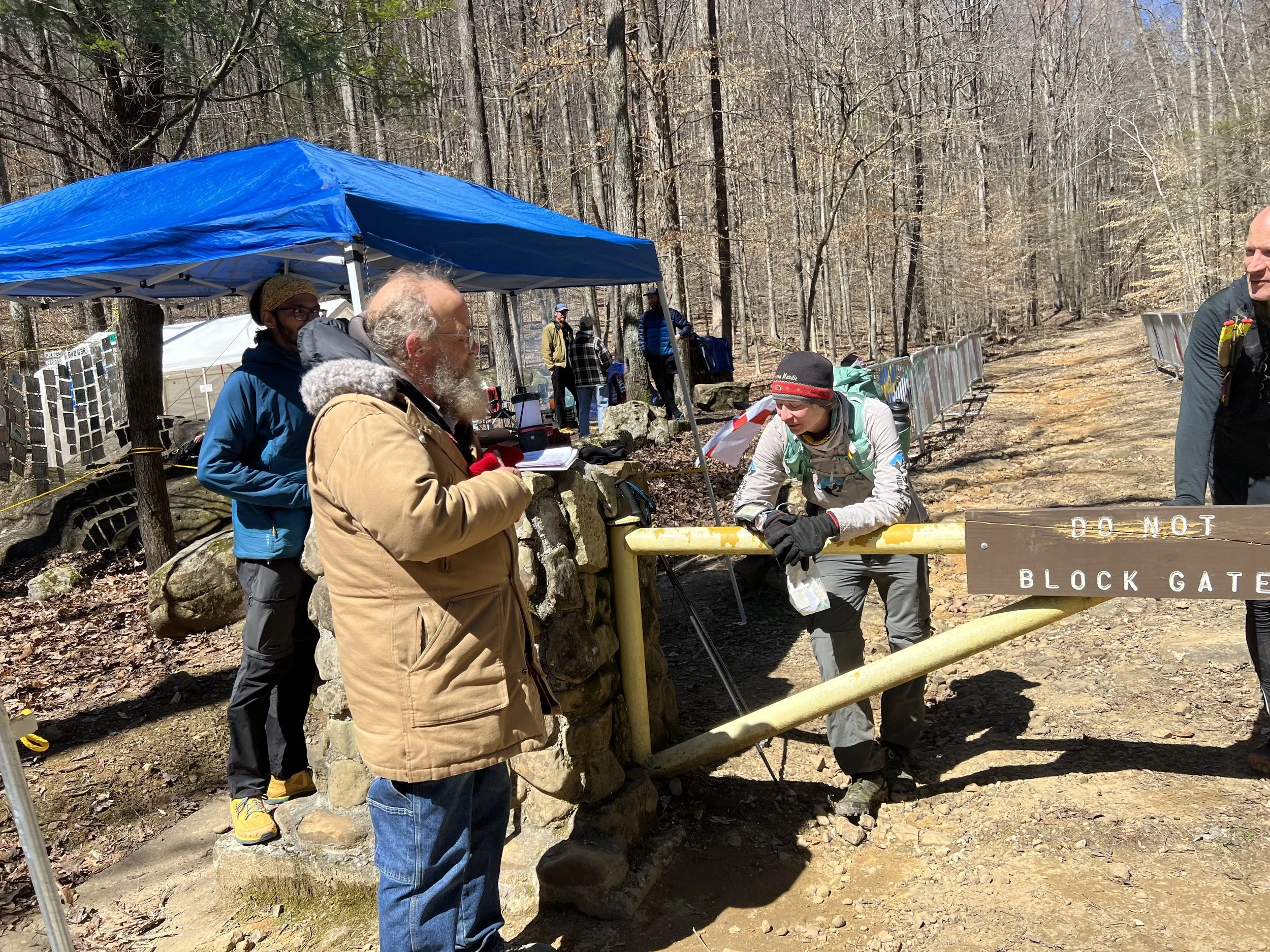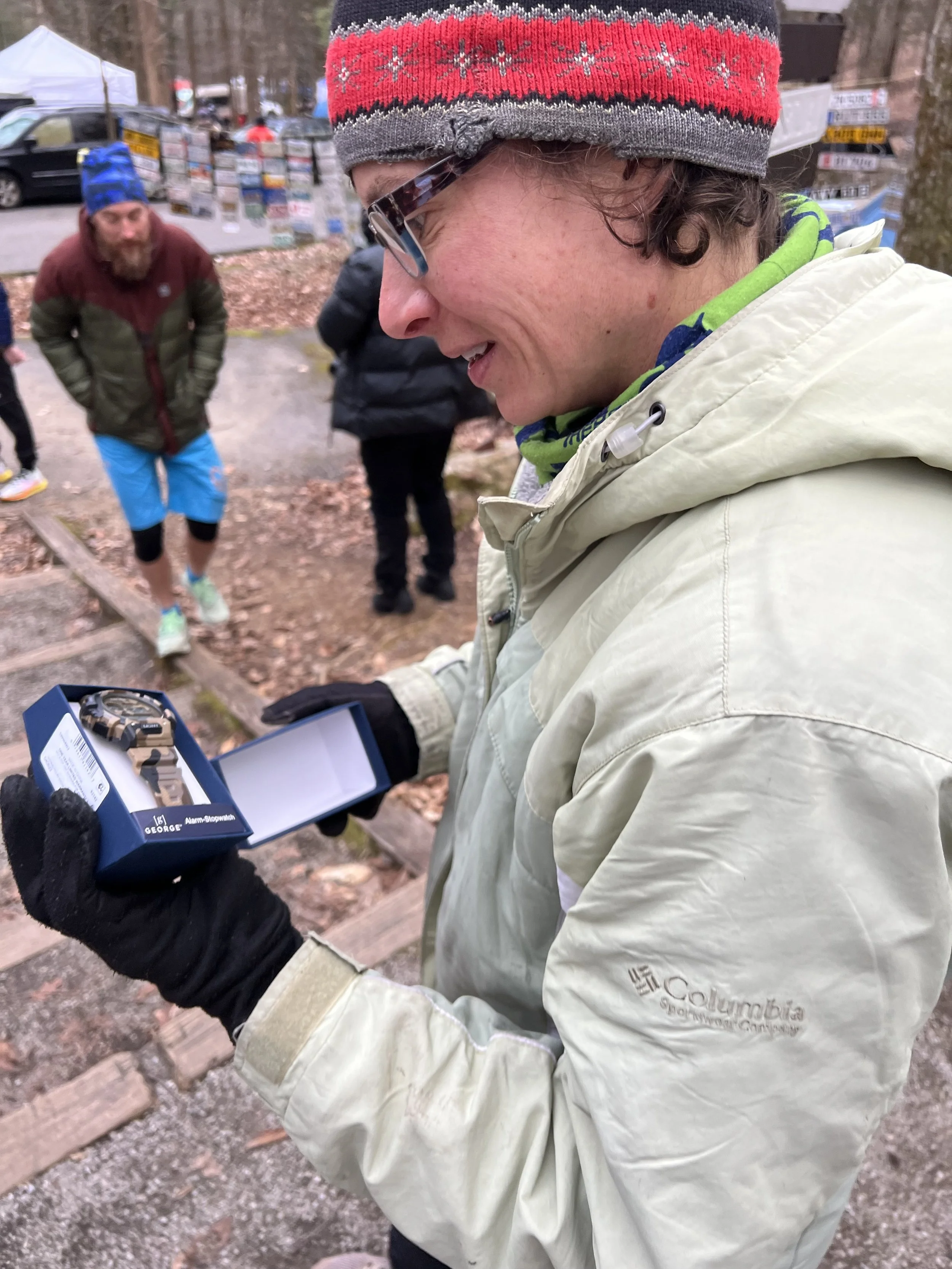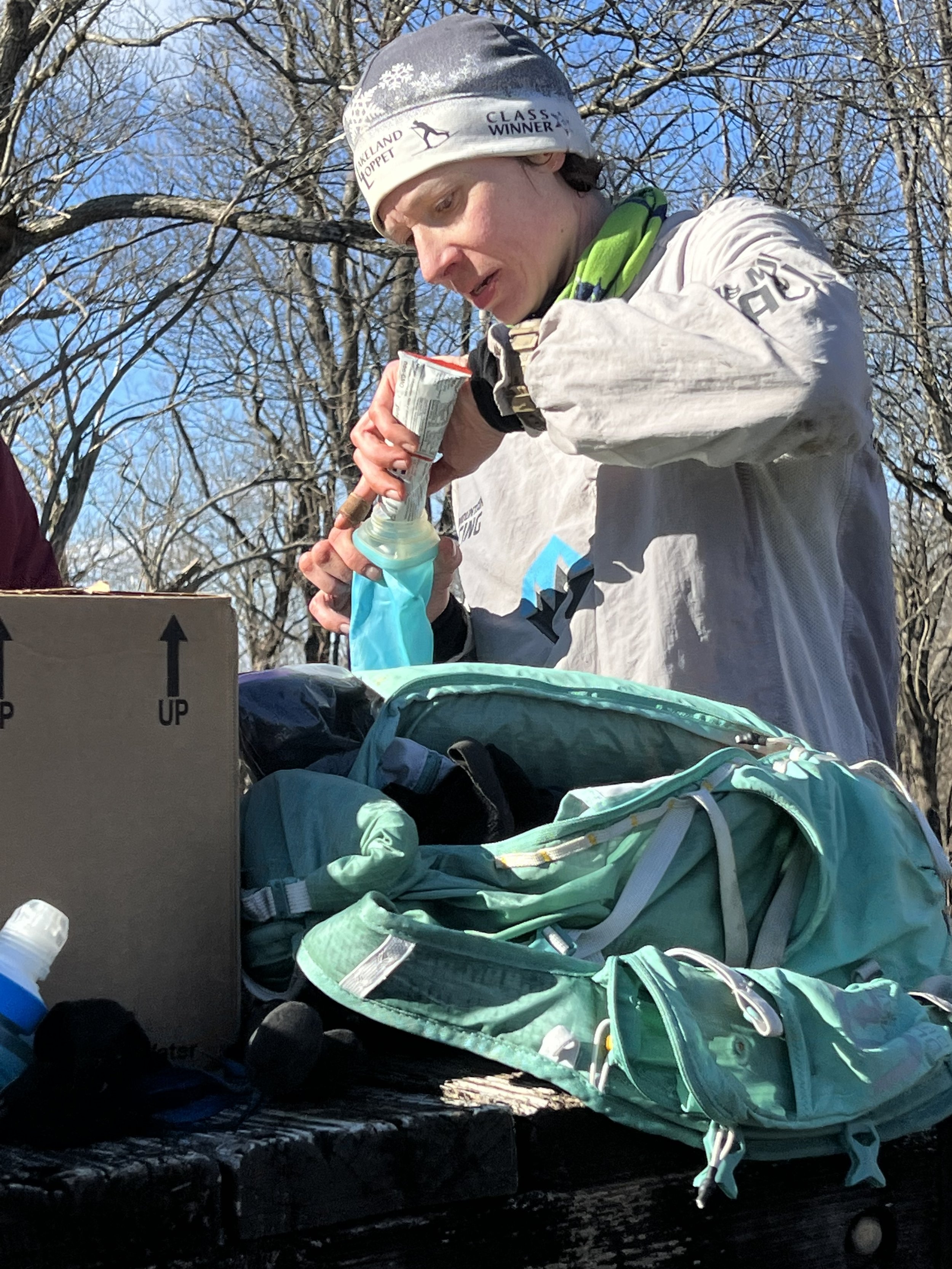Preparing for failure Part 3 - Gear
Preparing for Barkley requires more than just physical and mental preparations, which I dove into in my prior blog posts. In this blog, I dive into my least favorite aspect to tackle, gear.
One variable in our control
Frozen Head State Park is situated on the west fringe of the Cumberland Mountains. The park envelopes thirteen peaks over 3000 feet, rising 1400-1800 feet over the surrounding terrain. As a result, a microclimate that can dish out any possible weather in spring. Within 12 hours (so within one loop) temperatures can swing 70F. Pile that onto the body’s stress from the physical demands of the course results in an inability to cope with the swings. Following a year when the majority of the field dropped during a night of cold rain, and knowing my body already struggles in the cold, I invested in high quality gear.
Nervously awaiting the lighting of the cigarette at the start line. I modified my pack by adding two extra pockets for food on the waist belt.
During one of my first longer winter runs, I came to the realization that I had never done long endeavors in cold temperatures. My mindset would need to change for my normal 1-3 hours vs. 8-12 hours in the potential cold.
Although the race entry is about a penny a mile, at $1.60, the amount I spent on gear was more than I probably spent on gear over the past decade, despite no required gear list for the event. I initially looked at what past Barkers used but found some of the gear was no longer available or I had different preferences. Also, the good and bad about being a self-sponsored (aka non-sponsored) athlete is every brand of gear is on the table. My gear served me well, getting me through both a clockwise and counterclockwise loop before I keep in minutes over the time limit.
Trekking Poles - Black Diamond Distance Z Trekking Poles
One piece of gear I didn’t need to buy for the race was a watch since racers are provided a watch with non-GPS capabilities.
Initially I resisted poles. It didn’t help my spur-of-the-moment idea to try poles for the first time consisted of taking my classic rollerski poles with me after my rollerski-to-run transition as part of one of my longest runs leading into a 100 miler. The poles were too long and amazingly heavy, despite never noticing their weight rollerskiing. At one point I ditched them on the trail. Not a good start.
It took me a long time to overcome the negative stigma, but I kept at it. Nearly every racer uses poles at Barkley and knowing my quads are my weak point, so poles would save the wear and tear for the 70,000 feet of descent. Eventually, I reached the point where the poles weren’t bogging me down on hill repeats. It would take a lot longer before I didn’t feel like an octopus for hydration and nutrition.
After I overcame the learning curve, it required many weeks before I settled on a single pair. With thousands of hours rollerskiing and cross country skiing, I was initially turned off by the basic loop grips of the Black Diamond poles. However, over time, I realized they did the job. After reading so many race reports with people snapping poles and having to use sticks, I opted for a slightly heavier aluminum pole over carbon in hopes the aluminum might bend but not break on a fall or misplant. Although I witnessed three broken poles during the race (which definitely hindered those racers on the rest of those loops), my poles held up well and I don’t know how I would have gotten up the steep ascents without them!
Footwear - inov-8 Mudclaw with All Terrain Gaiters and Showers Pass Waterproof Socks
My gaiters were intended to keep debris out of my shoes bushwhacking, but I came to love them to keep snow out of my shoes and my feet dry for hours during my winter training. I had intended to try out gaiters for years and I’m glad I finally have this gear in my arsenal to aid with future trail running and adventure racing pursuits. After my feet going numb after just two hours of running through slush and freezing rain in my Gore-Tex shoes and warmest wool socks, I invested in waterproof socks. With multiple stream crossings in the Barkley with potential sub-freezing temperatures, waterproof socks were a worthy investment and my feet never went numb from cold (although my big toes were numb for several days due to the physical beating and my husband nicknamed one “sausage toe” due to the swelling) and I didn’t have a single blister thanks to Bag Balm.
Although I didn’t use Gore-Tex shoes during the race and previously disliked them for most other conditions, inov-8 Roclite 345 GTX hiking boots proved invaluable in the snow training. Initially I purchased them to protect my weak ankles bushwashing, but they were not only my go-to for all my navigation practice but almost all my long runs since they would keep my feet dry for hours trekking through snow.
For the race, we had ideal footing with the ground frozen for most of the race. I even made it down Leonard’s Buttslide twice without a single fall! My inov-8 Mudclaw shoes were my first non-Nike Pegasus running shoe purchase since my track spikes in fifteen years, which proved superior on steep hillsides (and icy hill repeats).
After some experimenting, we figured calcium chloride would provide about 20-30 minutes of heat during cold rain.
Hands - Showers Pass Waterproof Knit Glove, Toko Overmitt, Gordini Challenge Mitten, and Smartwool Merino Glove
My biggest fear for Barkley was that my fingers would get so numb due to Raynaud's I would not be able to tear out book pages, access my pack/food, and unzip my pants to pee forcing me to quit. As a result, I carried six pairs of mitts/gloves, and three sets of handwarmers the entire race plus I wore arm sleeves. With the cold temperatures and dry conditions, I threw in my trusty ski mitts last minute, which I have used to train throughout the past two winters. I even researched and experimented with alternative hand warmers that would function while wet. I unwrapped most of my food so I wouldn’t have to take off my gloves to open, selecting foods (like nuts and cookies) that would be chewable in the sub-freezing temperatures.
To minimize stoppage time and need to handle a map, especially with poles, I used a clue sheet on my forearm. This was a trick from my adventure racing that was extremely helpful. I recorded key bearings on waterproof paper then used a wrist compass to ensure I remained on course while keeping my hands free.
Hydration - Katadyn BeFree 0.6L
I spent more time than I care to admit on selecting a pack.
It took until the day before the race before I settled on my hydration system. With my experience of my bladder hose freezing when I’d forget to blow air back through the tube, I opted for two soft flasks and a hard bottle. Since it was possible the water jugs may freeze in the cold temperatures, I brought my water filter. I’ve very happy I brought it since I drank more than I expected and filtered water frequently on course. I brought a hard bottle in case my soft flask punctured from briars or I needed to filter extra water to mix extra Tailwind. About half of my calories for each lap were Tailwind to keep my hands free to use my poles and the remainder as food.
Lighting - Fenix HM65R-T Headlamp and Ultrapire Lumen 600 Waist Light
Lighting technology has sure improved over the years! I was impressed at the quality of light I got for the amount I spent. After several prior Barkers and adventure racing teammates recommended the same lighting, this was a pretty easy decision. Over the single night of racing, I didn’t need to change any batteries. I also bought a waist light so I wouldn’t be blind in the fog, although I didn’t expect to ever use it again. I was happy I didn’t need to use it.
I’d often make “discoveries” on my bushwacks - here I found an old school trail marker made by bending the sapling.
Gear, gear, and more gear - Ultimate Direction Fastpackher 20, Outdoor Research Helium Rain Jacket, KanPas Wrist Compass, Rail Riders Adventure Top, and Columbia Silver Ridge Convertible Cargo Nylon Hiking Pants
Gear included pretty much everything including rain jackets and pants to replace my decade old cheaper rain gear, wrist and baseplate compasses, glove liners, waterproof mitts, base layers, waterproofing solution, down to merino wool underwear and waterproof socks. A few items I didn’t buy were my racing top and trekking pants which have been reliable in many adventure races and in the Barkley Fall Classic. Additionally I wore my old favorite ski hats (one which I paid a quarter for at a garage sale in 2012) and a buff which I trained in all winter. I wore a pair of tights that I owned for the past 20 years under my trekking pants and the matching top along with a Smartwool base layer.
Once I purchased the last of my gear, a huge weight was off my shoulders. The last thing I wanted to knock me out of Barkley was a variable I had total control of. I spent more hours than I want to admit researching packs and lights, for my first ever purchases of these items; however, I look forward to many more adventures utilizing this gear.
Banner photo: My gear served me well at the Barkley Marathons until timing out on loop two.
Next up
Be sure to follow my blog to read my race report and follow along for my other adventures!
Related:
Preparations for Failure Part 2 - Mental Training
Preparations for Failure Part 1 - Physical Training
Barkley Fall Classic 2022 recap on The Inspirational Runner Podcast
Barkley Fools - Frozen Head State Park training






